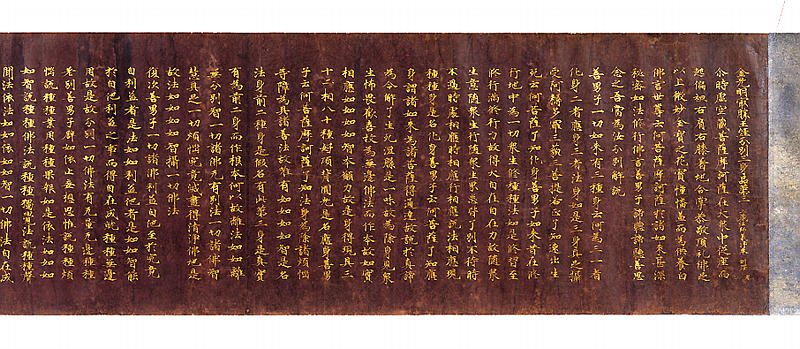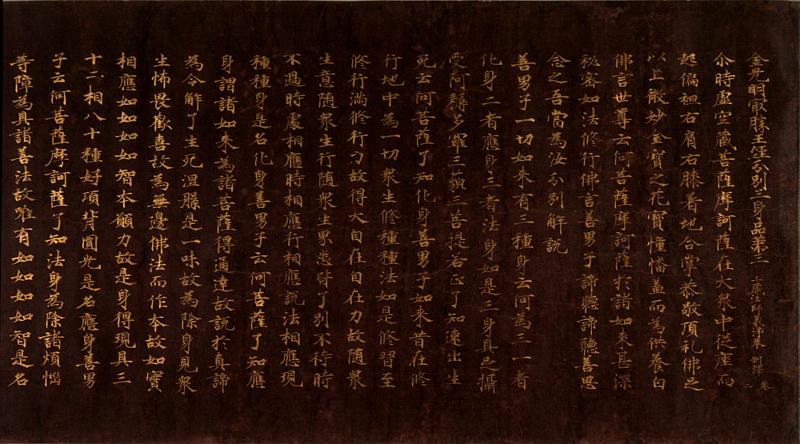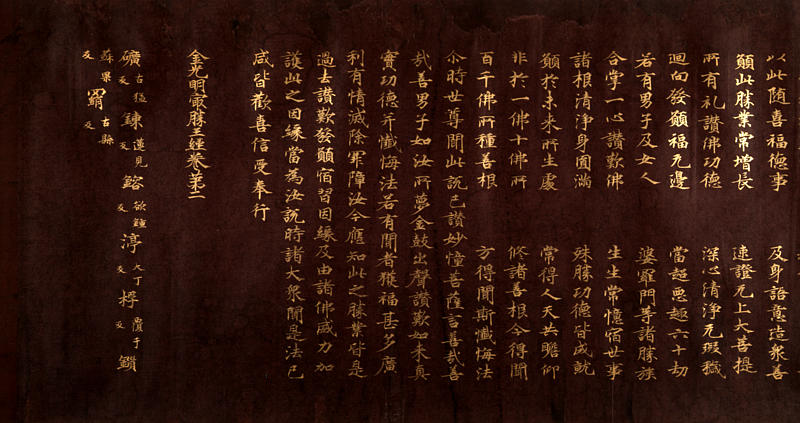Golden Light Sutra, Scroll 2
- Japan
- Nara period
- 8c
- Handscroll, gold paint on purple paper
- H-25.5 W-795.7
- Important Cultural Property
Catalogue Entry
(s: Suvarna-prabhasotta-ma-raja Sutra),
Scroll 2
Nara period, 8th century
Handscroll, gold paint on purple paper
Height, 25.5cm; overall length, 795.7cm
This sutra is the 2nd scroll of the 10 scrolls of the Konkomyo-Saisho-O-kyo Sutra as translated by I-ching (Gijo) of the Tang dynasty. Brushed in the powerful strokes of sutra script calligraphy of the Tempyo period (729-749) done in gold lettering on purple paper, this scroll is one of the so-called "Kokubunji Sutras" which were placed by Emperor Shomu's decree in the monastic temples built throughout the various regions of Japan (Kokubunji).
The Konkomyo Sutra is honored as the sutra text which protects the nation and teaches that the four guardian gods protect the nation. In 725 (Jinki 2), Emperor Shomu ordered the monks and nuns of Japan to recite this sutra, and in 728 he decreed that this sutra would be transcribed and made available to the various regions of Japan where it would be then chanted. Continuing from these decrees, in 741 (Tempyo 13) the Emperor decreed that monasteries and convents should be built throughout Japan, and these monasteries were to be called "Konkomyo shiten'no gokoku no ji," or loosely translated, the "Konkomyo four guardian god temples to protect the nation."
This sutra transcription project was carried out at the Shakinjikyojo, or "copying gold character sutra office," and by 746 (Tempyo 18), 71 parts of 700 scrolls of the Kokubunji Sutra had been copied. In this Shakinjikyojo, the sutras were copied by talented scribes whose calligraphy was dignified and suitable for such lofty subjects, and other artisans known as Eisei would use flat-bottomed barens to burnish the brushed gold characters. Even today we can see traces of burnishing on the paper, and this burnishing is the secret to the true brilliance and sparkle of the characters.
The paper has been dyed a deep purple color that is known as "antique purple," and gold lines--albeit extremely thin, sharp lines--have been used to set off the text area. A single sheet of paper has 26 lines of characters and an ongi, or pronunciation guide, has been attached at the end of the scroll to give the readings of the difficult characters used in the sutra.
This Kokubunji Sutra set is unsurpassed as one of the few remaining decorated sutras from the Nara period rich in both artistic beauty and historical importance. EA


